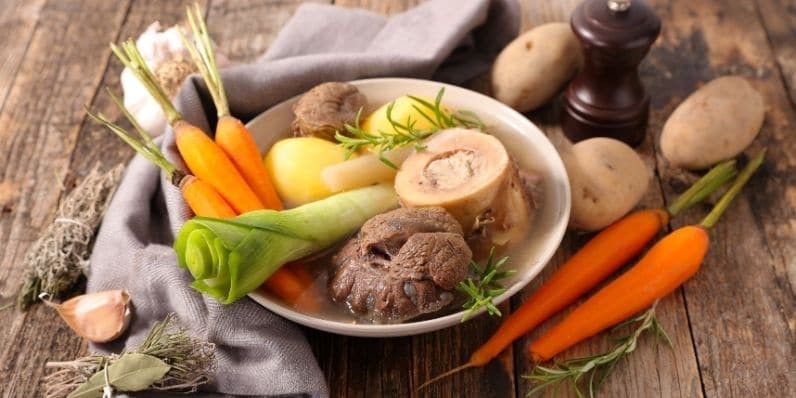Pot-au-feu, a hearty stew simmered with herbs, marrowbone, and root vegetables, often holds the title of France’s national food. This iconic dish, comparable to roast beef in England, embodies the essence of French culinary culture. Sharing pot-au-feu with family on a Sunday lunch feels inherently French, evoking a sense of egalité and fraternité. Traditionally cooked in large quantities, its simple yet flavorful ingredients make it accessible to all.
However, pot-au-feu’s history is more complex than its current status suggests. Its role and perception have evolved dramatically, reflecting shifts in socio-economic dynamics and even serving as a focal point for political discourse.
Humble Beginnings
The origins of pot-au-feu are somewhat murky. While similar dishes existed in Roman times, the earliest recorded mentions appear in the 12th century, albeit with limited detail. Initially, pot-au-feu was a modest meal primarily consumed by the poor.
Early recipes lacked standardization. Meat choices varied depending on availability. In rural areas, pork (often salted), bacon, or occasionally chicken were common. In urban centers, cheaper cuts of beef were more accessible. Vegetable selection was equally flexible, prioritizing root vegetables like carrots, parsnips, turnips, and celeriac, but also including cabbage, leeks, and even cauliflower based on region and season. The quality of ingredients was often basic, with tougher meat cuts and vegetables harvested well in advance.
The cooking method, as the name “pot in the fire” implies, remained consistent. Medieval peasant households typically maintained a single hearth with a continuously burning fire. An earthenware pot, suspended over the fire or placed beside it, held the ingredients, water, and slow-cooked for hours. The meat and most vegetables were eaten at lunch, the main meal, while the remaining broth simmered until dinner.
Pot-au-feu was not a daily staple. Meat consumption was infrequent for the poor, making it a dish reserved for special occasions, particularly during prosperous times. The presence of pot-au-feu became a barometer of both economic well-being and societal contentment.
From Peasant Fare to Aristocratic Tables
Towards the late 16th century, pot-au-feu’s social standing began to shift. Crop failures and epidemics during the Wars of Religion made it increasingly inaccessible to the poor. Simultaneously, it began to appear on the tables of the wealthy, who appreciated its simplicity during financially strained times. King Henri III requested it, and Madame de Sévigné recommended it in her letters. Marie-Catherine d’Aulnoy even lamented its absence in Spain.
This change in consumption led to a more refined recipe. While vegetable choices remained seasonal, meat selections began to reflect aristocratic preferences. Pork and bacon became less common, replaced by higher-quality beef cuts, often combined with chicken and veal. However, pot-au-feu never fully integrated into aristocratic cuisine. It remained a “peasant” dish, eaten infrequently and rarely featured in formal settings.
Embraced by the Middle Class
Pot-au-feu found its true social niche in the late 18th century. The emerging middle class, consisting of landowners and urban bourgeoisie, embraced the dish. With the financial means to afford quality meat and without the prejudices of the nobility, they adopted it as their own.
Under their influence, pot-au-feu survived the French Revolution and gained recognition as a “national” dish. By the Bourbon restoration, it was a dietary staple, prompting Marie-Antoine Carême, the founder of grande cuisine, to dedicate the first recipe in L’Art de la cuisine française (1833-34) to pot-au-feu. Its reputation as a quintessential French dish spread rapidly, attracting foreign interest. Johann Wolfgang von Goethe, for example, sampled it while following the Prussian army through Lorraine in 1792.
A Symbol of Social Division
Paradoxically, pot-au-feu’s association with the middle class led to increased social division. During the Second Empire, the middle class thrived, leading to tensions with organized labor and radical republicans. Pot-au-feu became a symbol of this contested social position. Some bourgeois writers viewed it as representing traditional values, while others saw it as emblematic of bourgeois conformity and stifling of individualism.
Gustave Flaubert’s Le Château des cœurs (1863) provides a striking example. The play depicts a kingdom worshipping a giant cauldron of pot-au-feu, representing the middle class’s conservatism, materialism, and self-interest. The dish’s influence is portrayed as oppressive, with the hero imprisoned for refusing to taste it and the cauldron eventually plunging the city into darkness.
Democratization and National Identity
As the French economy recovered after Napoleon III’s abdication, social tensions eased, and pot-au-feu became more accessible. Cheaper meat cuts became available, allowing the working classes to enjoy it again. Initially reserved for festive occasions, it became associated with home comforts. Authors like Emile Zola, Guy de Maupassant, and Joris-Karl Huysmans depicted it as a simple pleasure, while Alexandre Dumas celebrated that his doorman likely ate a tastier pot-au-feu than the wealthy M. de Rothschild.
By the 20th century, pot-au-feu had truly become a central element of French cuisine. The post-World War II rise in living standards enabled most French families to afford meat regularly, making pot-au-feu a common Sunday meal. With the final social barriers removed, pot-au-feu had achieved its jour de gloire. Today, it remains a beloved dish, embodying the spirit of French culinary heritage and enjoyed by people from all walks of life.
